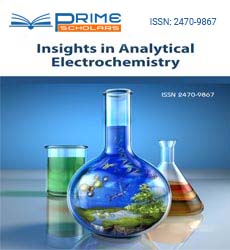Keywords
Sodium alpha olefin sulfonate; Dopamine; Ascorbic acid; Modified carbon paste electrode; Bare carbon paste electrode; Cyclic voltammetry
Introduction
The Sodium alpha olefin sulfonate (SAOS) surfactants are produced by the direct reaction of olefins with strong sulfonating agents, such as sulfur trioxide. This leads to the formation of surface active anionic mixtures containing both alkenes sulfonates and hydroxylalkene sulfonates. These surfactants may be used in place linear alkyl benzene sulfonate in many formulas with resulting improvements in biodegradability, mildness to skin, foaming and detergency. In addition, SAOS surfactants are stable over a much broader pH range than alkyl sulfates alkyl ethers sulfates and esters type surfactants. They also exhibit excellent foaming and detergency in hard water. The INCL name of the primary SAOS of commerce is sodium C14-16 olefin sulfonate. Irritation studies on SAOS have been conducted on the backs of ten human volunteers using the closed patch technique with daily applications of 2.5% aqueous solutions, It was shown that irritation was comparable to that produced by soap. The SAOS surfactants have been used successfully in the formulation of a variety of skin cleaning products including toilet bars and bubbles bath compositions, a suggested liquid bubble bath formulation containing SAOS. The trend in the cosmetic market to use liquid hand cleansers in place of bar soap continues to be strong. As a result of their relative mildness, cleansing efficiency outstanding lathering properties and favorable cost SAOS surfactants have gained popularity for this use [1-4].
The surfactants play very important role especially in electrochemistry and these are the active ingredients in personal hygiene products. These are helpful in detergents for industrial and household cleaning. There are four classes (cationic, anionic, amphoteric and non-ionic) based on the ionic charge (if present) of the hydrophilic portion of the surfactant in an aqueous solution [5,6]. These surfactants have an inherent tendency to accumulate at interfaces depending upon the nature of the interface and that of the surfactants. Accordingly, the properties which depend on the interfacial character of a system exhibit alteration in the presence of such surfactants [7-9]. Therefore the surfactants are frequently used in a variety of textile technology and biotechnology. The use of enzymes in detergents (primarily protease and amylase) needs biotechnological skills to solve problems like enzyme production and isolation, enzyme storage stability and preserving the activity, thermostability, pH stability etc., [10,11]. Hu’s group has introduced surfactants to electro analytical chemistry to improve the detection limits of some important biomolecules. The results showed that the electrochemical responses of these compounds were greatly enhanced in the presence of trace surfactant types [12-16].
Dopamine (DA) was discovered by Arvid Carlsson’s in 1958 and it plays very important role in the mammalian brain [17]. It is also an important neurotransmitter widely distributed in the mammalian central nervous systems. It has been discovered that, the lack of DA is associated with the debilitating ailment i.e., Parkinson’s disease [18,19], HIV infection and Huntington’s diseases. In the past 30 years, a variety of approaches, including spectrophotometry, colorimetry, chromatography, have been developed for the DA detection by different techniques. The DA can be detected using electrochemical techniques due to its good electro active nature. Therefore, the electrochemical methods for quantifying the amount of DA in human body fluids have attracted more attentions due to its high accuracy, fast response and bulk modification with simple instruments [20-30].
Ascorbic acid is a water soluble vitamin and it is a compound that takes part in many important life processes. It is one of the most important vitamins, due to its antioxidant and pH regulator properties often being added to various food products and pharmaceuticals [31,32]. Ascorbic acid (AA) prevents scurvy and is known to take part in several biological reactions. It has been widely used in foods and drinks as an antioxidant and also for the prevention and treatment of common cold, mental illness, infertility, cancer and AIDS [33,34]. Now-a-days this compound has been the subject of many electrochemical investigations and on the basis of such studies; several methods have been developed for its determination in various samples [35-42].
In the present work, the SAOS anionic surfactant was modified and applied for the electrochemical detection of DA and AA at pH 7.2 PBS solution. The modified electrode shows good electro catalytic activity and enhancement in current signals with the decreasing over potential for DA. After the modification of the electrode, the adsorption of SAOS on the surface of carbon paste electrode interface and the redox reactions in solution leads to acts as electrochemical sensor. These results might be able to explain the enhancement effects of surfactants in electro analytical chemistry [43].
Experimental Part
Reagents and chemicals
Dopamine (DA), Ascorbic Acid (AA) and Uric Acid (UA) were obtained from Himedia chemical company and of analytical grade used without further purification. 25 × 10-4 M DA stock solution was prepared in 0.1 M perchloric acid, 25 × 10-4 M AA was prepared in double-distilled water and 25 × 10-4 M UA was prepared in 1 M NaOH. Graphite powder of 50 mm size was purchased from Loba, silicon oil was purchased from Himedia and Sodium alpha olefin sulfonateanionic surfactant was purchased from Himedia chemical company. The chemicals for preparation of buffer solution were purchased from Merck. Phosphate buffer (0.2 M pH 7.2) was used as supporting electrolyte.
Apparatus
Cyclic voltammetry (CV) was performed in a model CHI-660c (CH Instrument-660 electrochemical workstation). All experiments were carried out in a conventional electrochemical cell. The electrode system contained a carbon paste working electrode (3.0 mm in diameter), a platinum wire as counter electrode and saturated calomel as reference electrode for the electrochemical measurements. The carbon paste electrode was prepared by using 70% graphite powder and 30% silicone oil were mixed by hand to produce a homogeneous carbon paste. The paste was then packed into the cavity of a homemade carbon paste electrode and smoothed on a weighing paper. In the same way, the sodium alpha olefin sulfonate modified carbon paste electrode (SAOS MCPE) was prepared by immobilizing 10 µL of SAOS on the surface of the carbon paste electrode for 5 min and then applied for the electrochemical analysis.
Results and Discussion
Electrochemical response of potassium ferrocyanide at sodium alpha olefin sulfonate modified carbon paste electrode
Due to the simple and well defined response at carbon materials the Fe(CN)6-3/Fe(CN)6-4 redox couple has been widely used to characterize the surface properties of all kinds of carbon electrodes [44-48]. Potassium ferrocyanide was selected to evaluate the performance of the modified CPE electrode. Figure 1 shows the electrochemical response of 1mM K4Fe(CN)6 bare (dashed line) and SAOS/MCPE (solid line) in supporting electrolyte 1 M KCl at the scan rate 50 mVs-1. The modified carbon paste electrode peak current increases when compared to bare carbon paste electrode. This may be due to SAOS surfactant plays an important role in the electro active surface area and provides the conducting bridges for the electro transfer of ferrocyanide [49-53].
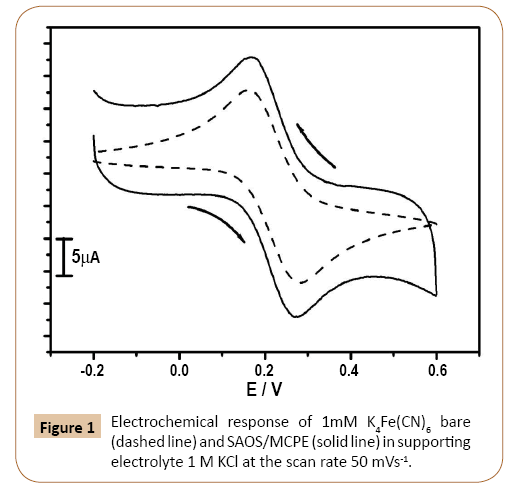
Figure 1: Electrochemical response of 1mM K4Fe(CN)6 bare (dashed line) and SAOS/MCPE (solid line) in supporting electrolyte 1 M KCl at the scan rate 50 mVs-1.
Effect of scan rate of potassium ferrocyanide
Figure 2a explains the SAOS/MCPE was recorded at the different scan rates for potassium ferrocyanide with 1M KCl as a supporting electrolyte. The peak currents of K4Fe(CN)6 at SAOS/MCPE increased linearly with increasing the scan rate from 50-500 mVs-1. The Ipa versus υ1/2 shows linear with the correlation coefficient R2=0.9978 (Figure 2b) respectively. This indicates that SAOS/MCPE shows diffusion -controlled process [54].
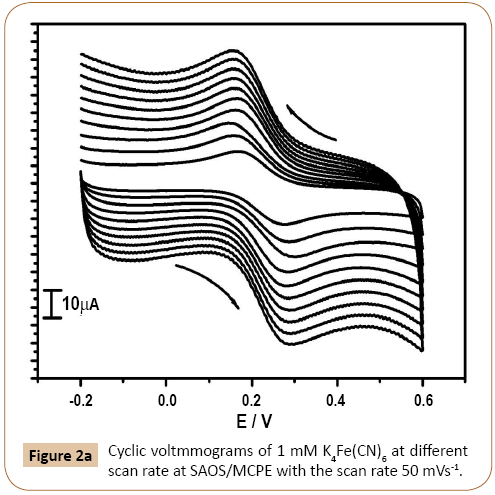
Figure 2a: Cyclic voltmmograms of 1 mM K4Fe(CN)6 at different scan rate at SAOS/MCPE with the scan rate 50 mVs-1.
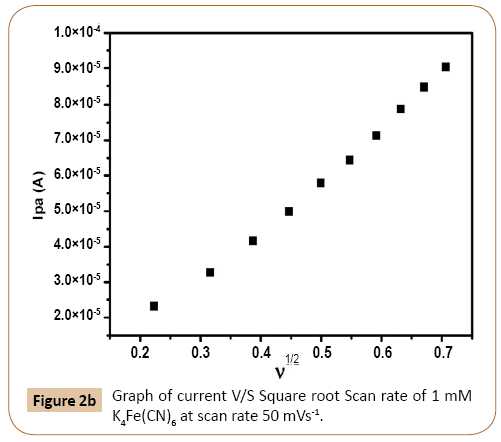
Figure 2b: Graph of current V/S Square root Scan rate of 1 mM K4Fe(CN)6 at scan rate 50 mVs-1.
Electrochemical response of dopamine at SAOS/ MCPE
Figure 3 shows the cyclic voltammograms for the bare CPE (dashed line) and SAOS MCPE (solid line) in the presence of 0.1 × 10-4 M DA at pH 7.2 PBS solution with the scan rate 50 mVs-1. At bare CPE shows difference in peak potential (ΔEp=47 mV) with low current signal. However at SAOS/MCPE the peak current was strongly increases (Ip) with peak potential difference (ΔEp=35 mV). This indicates the SAOS/MCPE shows good electro catalytic properties.
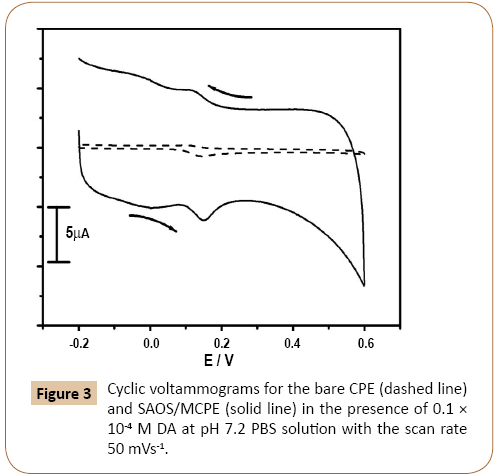
Figure 3: Cyclic voltammograms for the bare CPE (dashed line) and SAOS/MCPE (solid line) in the presence of 0.1 × 10-4 M DA at pH 7.2 PBS solution with the scan rate 50 mVs-1.
Effect of scan rate
The cyclic voltammograms of 0.1 × 10-4 M DA at SAOS/MCPE was studied at different scan rates at pH 7.2 PBS solution as shown in the Figure 4a and the observations was made to investigate the kinetics of the modified electrode reaction [55]. With the increase in the scan rate from 10-300 mVs-1 the anodic and cathodic peak currents goes on increasing. The plot of Ipa versus υ shows linear regression equation Ipa=-5.608 × 10-7+0.1311 (υ)R2=0.9996 (Figure 4b) respectively. This indicates that electron transfer process was adsorption-controlled process for DA.
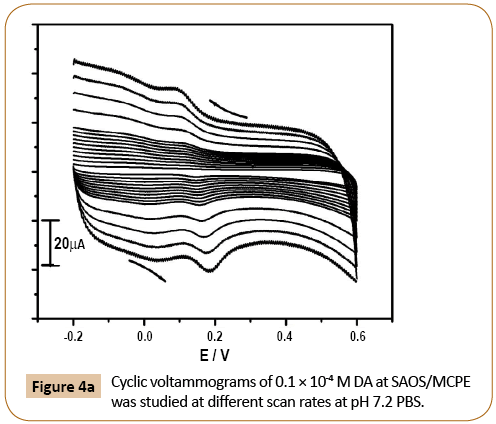
Figure 4a: Cyclic voltammograms of 0.1 × 10-4 M DA at SAOS/MCPE was studied at different scan rates at pH 7.2 PBS.
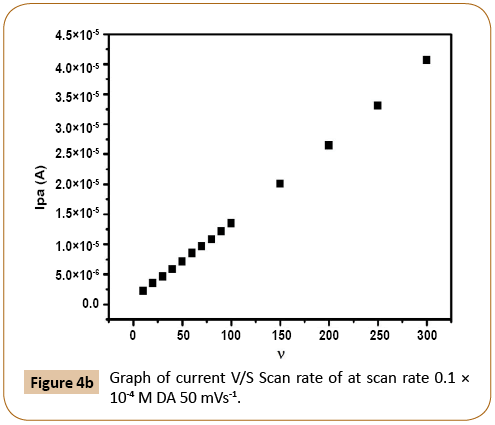
Figure 4b: Graph of current V/S Scan rate of at scan rate 0.1 × 10-4 M DA 50 mVs-1.
Effect of dopamine concentration
The effect of dopamine concentration was studied at SAOS/ MCPE in the range (0.1-0.8 × 10-4 M) at pH 7.2 as shown in the Figure 5a. As the concentration of DA was increased, the anodic and cathodic peak currents also increases and the plot of Ipa versus DA concentration shows increase in electrochemical peak currents with linear regression equation Ipa (µA)=2.840 × 10-5 (C) M/L+5.3776 (µA) (R2=0.9913) as shown in the Figure 5b. The detection limit was calculated by using the formula (1) [56], where S is the standard deviation and M is the slope obtained from the calibration plots. The detection limit for dopamine was found to be 1.05 × 10-6 M.
LOD=3S/M…………… (1)
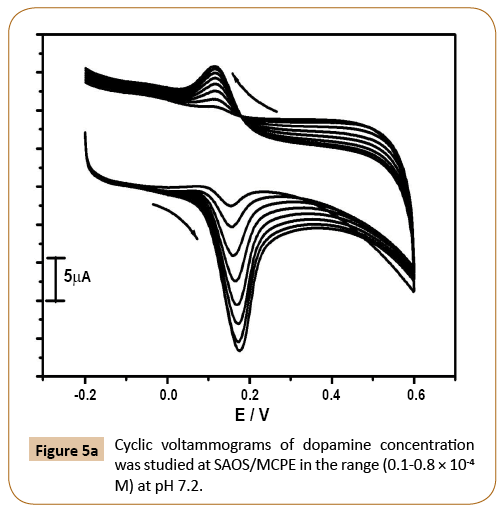
Figure 5a: Cyclic voltammograms of dopamine concentration was studied at SAOS/MCPE in the range (0.1-0.8 × 10-4 M) at pH 7.2.
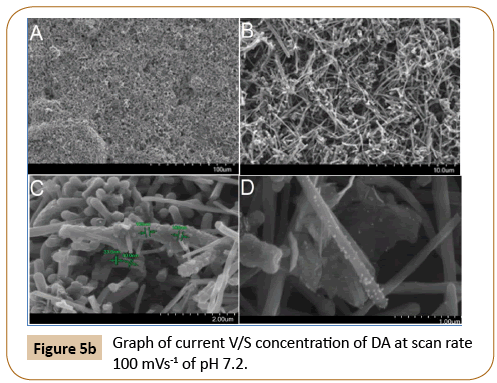
Figure 5b: Graph of current V/S concentration of DA at scan rate 100 mVs-1 of pH 7.2.
Simultaneous determination of DA and AA by cyclic voltammetry
The main objective of the work is to determine the 0.5 × 10-4 M DA and 2 × 10-4 M AA simultaneous at SAOS/MCPE in 0.2 M PBS of pH 7.2 system as shown in the Figure 6. The bare CPE (dashed line) shows one broad peak for both the analysts and it indicates that the bare CPE fails to separate the voltammetric signals for DA and AA. This is due to the electrode fouling effect and the fact that their oxidation potential is indeed quite close. The oxidized DA product, dopamine-o-quinone, can also be catalytically reduced to DA by AA again becoming available for oxidation [57-59]. On the other hand, SAOS/MCPE (solid line) exhibits two well oxidation peaks of DA and AA at 151 mV and 24 mV with the enhancement in the Ipa current of DA and AA respectively. This indicates that the modified electrode acts as a electrochemical sensor for the dopamine.
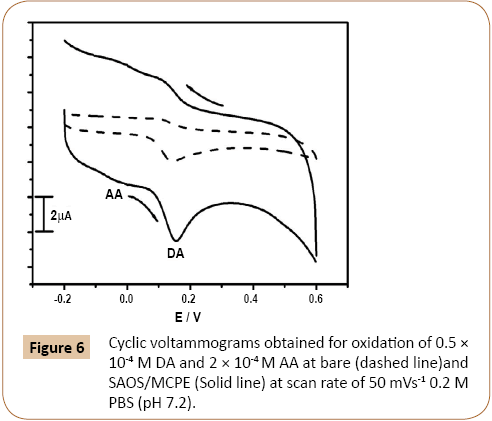
Figure 6: Cyclic voltammograms obtained for oxidation of 0.5 × 10-4 M DA and 2 × 10-4 M AA at bare (dashed line)and SAOS/MCPE (Solid line) at scan rate of 50 mVs-1 0.2 M PBS (pH 7.2).
Simultaneous determination of DA and AA by DPV technique
The simultaneous determination of DA and AA was carried out in the potential range of -0.4 to 0.6 V at pH 7.2 as shown in the Figure 7. The modified carbon paste electrode is able to separate two well-defined peaks of DA and AA on 0.067 and 0.139 mV respectively [60]. The Figure 8a shows that the concentration of DA was varied from (10 × 10-6 to 90 × 10-6 M) by keeping AA remains constant at SAOS MCPE. The plot of Ipa versus DA (Figure 8b) indicates that, the concentration of DA was increasing linearly and the corresponding DA linear regression equation is Ipa (µA)=0.812(C) µM/L+11.60 (µA) R2=0.9973. The detection limit (LOD) was calculated by using the formula (1) [61-66] and obtained results was shown in the Table 1.
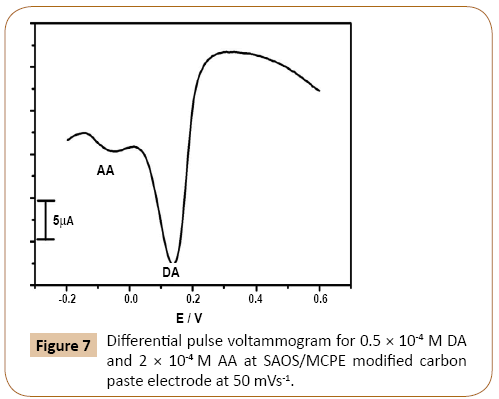
Figure 7: Differential pulse voltammogram for 0.5 × 10-4 M DA and 2 × 10-4 M AA at SAOS/MCPE modified carbon paste electrode at 50 mVs-1.
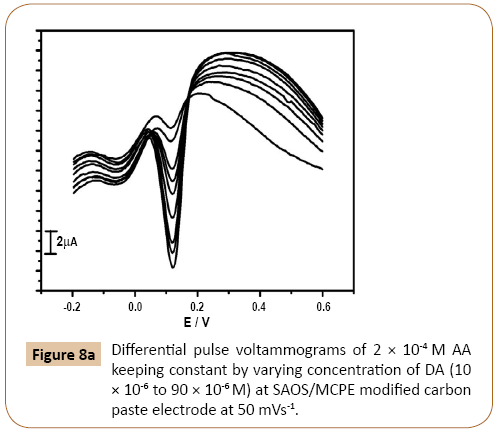
Figure 8a: Differential pulse voltammograms of 2 × 10-4 M AA keeping constant by varying concentration of DA (10 × 10-6 to 90 × 10-6 M) at SAOS/MCPE modified carbon paste electrode at 50 mVs-1.
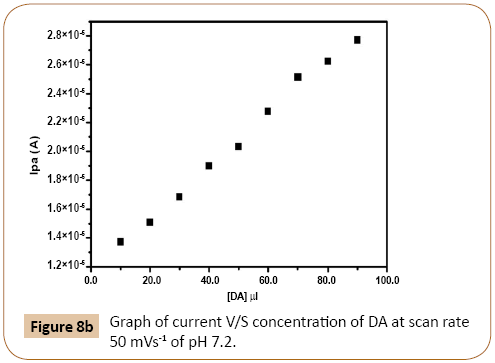
Figure 8b: Graph of current V/S concentration of DA at scan rate 50 mVs-1 of pH 7.2.
| Electrode |
Detection Limit (µM) |
Method |
Reference |
| Au-CA SAMs |
2.34 |
DPV |
[61] |
| a-CD/CNT/PGE |
1.0 |
DPV |
[62] |
| Metallothioneinsself-assembledgoldelectrode |
6.0 |
CV |
[63] |
| HydrogenatedcylindricalCarbonelectrodes |
7.0 |
CV |
[64] |
| Lignin Modified Carbon Paste Electrode |
14.0 |
CV |
[65] |
| Long-Length Carbon Nanotube |
0.02 |
DPV |
[66] |
| GNS-CNTs/MoS2 |
0.05 |
DPV |
[67] |
| SAOS MCPE |
0.64 |
DPV |
This work |
Table 1: Detection limit (LOD) values.
Conclusion
In this work, the sodium alpha olefin sulfonate MCPE shows good electro catalytic properties towards electrochemical determination of dopamine in PBS solution at pH 7.2. The effects of scan rate and the concentration were found to be adsorptioncontrolled process. The SAOS/MCPE was able to determine AA and DA simultaneously in both the CV and DPV techniques in their sample mixtures and the detection limit of DA was found to 1.05 × 10-6 M. This indicates that the modified electrode act as good sensors for DA and this method can also be applied for other neurotransmitters.
References
- Rieger MM, Rhein LD (1997) Surfactants in cosmetics. 2nd edn. Marcel Dekker Inc., New York, USA 68: 97-57.
- Bioterge (2012) Alpha olefin Sulfonate. Bulletin Stepan Chemical Co., Northfield, IL, USA 800: 745-7837.
- Rouge BL (1979) Commuinique. Toxicity Studies on Sodium Alpha Olefin Sulfonte, Ethyl Corporation, p: 24.
- Barker G (1975) Cosmetic Formulation of Skin Care Products 90: 70.
- Levine LH, Garland JL, Johnson JV (2005) Simultaneous quantification of polydispersed anionic, amphoteric and nonionic surfactants in simulated waste water samples using C18 high-performance liquid chromatography–quadrupoleion-trap mass spectrometry. Journal of Chromatography A 1062: 217-225.
- Yuksel E, Sengil IA, Ozacar M (2009) The removal of sodium dodecyl sulfate in synthetic wastewater by peroxi-electrocoagulation method. Journal of Chemical Engineering 152: 347-353.
- Singh K, Tiwari AK, Dwivedi CS (2003) Electrochemical studies on surfactant-modified cellulose acetate membrane. J Colloid Interface Sci 266: 403-406.
- Rosen MJ (1989) Surfactants and Interfacial Phenomena. 2nd edn. Wiley -Interscience, NewYork 431.
- Fridrikhsberg DA (1986) A Course in Colloid Chemistry. Translated by G. Leib, Mir Publisher, Moscow.
- Bosnar MS, Grabari Z, Grabari BS (2004) Surfactant Sensors in Biotechnology Part 1-Electrochemical Sensors Electrochemical Sensors in Biotechnology, Food Technology and Biotechnology 42: 197-206.
- Singh J, Batra N, Sobti R C (2004) Purification and characterisation of alkaline cellulase produced by a novel isolate, Bacillus sphaericus JS1. Journal of Industrial Microbiology Biotechnology 31: 51-56.
- Chitravathi S, Kumara Swamy BE, Niranjana E, Chandra U, Mamatha GP, et al. (2009) Electrochemical Studies of Sodium Levothyroxine at Surfactant Modified Carbon Paste Electrode. International Journal of Electrochemical Science 4: 223-237.
- Hu S, Yan Y, Zhao Z (1991) Determination of progesterone based on the enhancement effect of surfactants in linear sweep polarography. Analytical Chimica Acta 248: 103-108.
- Yi H, Wu K, Hu S (2001) Adsorption stripping voltammetry of phenol at Nafion-modified glassy carbon electrode in the presence of surfactants. Talanta 55: 1205-1210.
- Zhang S, Wu K, Hu S (2002) Voltammetric determination of diethylstilbestrol at carbon paste electrode using cetylpyridine bromide as medium. Talanta 58: 747-754.
- Dauer W, Przedborski S (2003) Parkinson's disease: mechanisms and models. Neuron 39: 889-909.
- Abbaspour A, Noori A, (2011) A cyclodextrin host–guest recognition approach to an electrochemical sensor for simultaneous quantification of serotonin and dopamine. Biosensors and Bioelectronics 26: 4674-4680.
- Li Y, Huang X, Chen Y, Wang L, Lin X (2009) Simultaneous determination of dopamine and serotonin by use of covalent modification of 5-hydroxytryptophan on glassy carbon electrode. Microchimica Acta 164: 107-112.
- Li S, He J, Zhang M, Zhang R, Lv X, et al. (2013) Electrochemical detection of dopamine using water-solubled grapheme. Electrochimica Acta 102: 58-65.
- Damier P, Hirsch EC, Agid Y, Graybiel AM (1999) The substantia nigra of the human brain. II. Patterns of loss of dopamine-containing neurons in Parkinson's disease. Brain 122: 1437-1448.
- Merims D, Giladi N (2008) Dopamine dysregulation syndrome, addiction and behavioural changes in Parkinson’s disease. Parkinsonism Relat Disord 14: 273-280.
- Abbaspour A, Khajehzadeh A, Ghaffarinejad A (2009) A simple and cost-effective method, as an appropriate alternative for visible spectrophotometry: development of a dopamine biosensor 134: 1692-1698.
- Lin Y, Chen C, Wang C, Pu F, Ren J, et al. (2011) Silver nanoprobe for sensitive andselective colorimetric detection of dopamine via robust Ag-catechol interaction. Chemical Communications 47: 1181-1183.
- Carrera V, Sabater E, Vilanova E, Sogorb M A (2007) A simple and rapid HPLC-MS method for the simultaneous determination of epinephrine, norepinephrine, dopamine and 5-hydroxytryptamine: application to the secretion of bovine chromafin cell cultures. Journal of Chromatography 847: 88-94.
- Li F, Chai J, Yang H, Han D, Niu L (2010) Synthesis of Pt/ionic liquid/graphene nanocomposite and its simultaneous determination of ascorbic acid and dopamine 81: 1063-1068.
- Ping J, Wu J, Wang Y, Ying Y (2012) Simultaneous determination of ascorbic acid, dopamine and uric acid using high-performance screen-printed graphene electrode. Biosensors and Bioelectronics 34: 70-76.
- Kim YR, Bong S, Kang YJ, Yang Y, Mahajan RK, et al. (2010) Electrochemical detection of dopamine in the presence of ascorbic acid using graphene modified electrodes. Biosens Bioelectron 25: 2366-2369.
- Wang Y, Li Y, Tang L, Lu J, Li J (2009) Application of graphene-modified electrode for selective detection of dopamine. Electrochemistry Communications 11: 889-892.
- Fashedemia OO, Ozoemenab KI (2011) A facile approach to the synthesis of hydrophobic iron tetrasulfophthalocyanine (FeTSPc) nano-aggregates on multi-walled carbon nanotubes: a potential electrocatalyst for the detection of dopamine. Sensors and Actuators 160: 7-14.
- Raghavendra NR, Niranjana E, Kumara Swamy BE, Sherigara BS, Jayadevappa H (2008) Surfactant induced iron (II) phthalocyanine modified carbon paste electrode for simultaneous detection of ascorbic acid, dopamine and uric acid. International Journal of Electrochemical Science 3: 1574-1583.
- Raoof JB, Ojani, Kiani A (2001) carbon paste electrode spiked with ferrocene carboxylic acid and its application to the electrocatalytic determination of ascorbic acid. Journal of Electroanalytical Chemistry 515: 45-51.
- Kaur B, Pandiyan T, Satpati B, Srivastava R (2013) Simultaneous and sensitive determination of ascorbic acid, dopamine, uric acid, and tryptophan with silver nanoparticles-decorated reduced graphene oxide modified electrode. Colloids and Surfaces B: Biointerfaces 111: 97-106.
- Arrigoni O, Tullio CD (2002) Ascorbic acid: much more than just an antioxidant. Biochemical BiophysicsActa 1569: 1-9.
- Shahrokhian S, Karimi M (2004) Voltammetric studies of a cobalt(II)-4-methylsalophen modified carbon-paste electrode and its application for the simultaneous determination of cysteine and ascorbic acid. Electrochimica Acta 50: 77-84.
- Amini MK, Shahrokhian S, Tangestaninejad S, Mirkhani V (2001) Iron(II) phthalocyanine-modified carbon-paste electrode for potentiometric detection of ascorbic acid. Anal Biochem 290: 277-282.
- Janda P, Weber J, Dunsch L, Lever ABP (1996) Detection of Ascorbic Acid Using a Carbon Fiber Microelectrode Coated with Cobalt Tetramethyl pyrido porphyrazine. Analytical Chemistry 68: 960-965.
- Turyan YI, Kohen R (1995) Formal redox potentials of the dehydro-l-ascorbic acid/l-ascorbic acid system. Journal of Electroanalytical Chemistry 380: 273-277.
- Pariente F, Alonso JL, Abruna HD (1994) Chemically modified electrode for the selective and sensitive determination of nitric oxide (NO) in vitro and in biological systems. Journal of Electroanalytical Chemistry 379: 191-197.
- Matos RC, Augelli MA, Pedrotti JJ, Lago CL, Agnes L (1998) Amperometric Differential Determination of Ascorbic Acid in Beverages and Vitamin C Tablets Using a Flow Cell Containing an Array of Gold Microelectrodes Modified with Palladium. Electroanalysis 10: 887-890.
- Zambonin CG, Losito I (1997) Kinetic Investigation of the Reactions Connected to the System Ascorbate + O2 by Amperometric Detection of H2O2 at a Modified Platinum. Analytical Chemistry 69: 4113-4119.
- Aguilar R, Davila MM, Elizalde MP, Mattusch J, Wennrich R (2004) Capability of a carbon–polyvinylchloride composite electrode for the detection of dopamine, ascorbic acid and uric acid. Electrochimica Acta 49: 851-859.
- Sharath SS, Kumara SBE, Chandra U, Manjunatha JG, Sherigara BS (2009) Simultaneous Determination of Dopamine, Uric Acid and Ascorbic Acid with CTAB Modified Carbon Paste Electrode. International Journal of Electrochemical Science 4: 592-601.
- Moore RR, Banks CE, Compton RG (2004) Basal Plane Pyrolytic Graphite Modified Electrodes:? Comparison of Carbon Nanotubes and Graphite Powder as Electrocatalysts Analytical Chemistry 76: 2677-2682.
- Banks CE, Moore RR, Davies TJ, Compton RG (2004) Investigation of modified basal plane pyrolytic graphite electrodes: definitive evidence for the electrocatalytic properties of the ends of carbon nanotubes. Chemical Communication 6: 1804-1805.
- Li J, Cassell A, Delzeit L, Han J, Meyyappan M (2002) Novel Three-Dimensional Electrodes:? Electrochemical Properties of Carbon Nanotube Ensembles. Journal Physical Chemistry B 106: 9299-9305.
- Niranjana E, Kumara SBE, Raghavendra NR, Sherigara BS, Jayadevappa H (2009) Electrochemical investigations of potassium ferricyanide and dopamine by sodium dodecyl sulphate modified carbon paste electrode: A cyclic voltammetric study. Journal of Electroanalytical Communication 631: 1-9.
- Banks CE, Moore RR, Davies TJ, Wildgoose GG, Compton RG (2005) Electrocatalysis at graphite and carbon nanotube modified electrodes: edge-plane sites and tube ends are the reactive sites. Chemical Communication 7: 829-841.
- Nagent JM, Santhanam KSV, Rubio A, Ajayan PM (2001) Fast Electron Transfer Kinetics on Multiwalled Carbon Nanotube Microbundle Electrodes. Nano Letters 1: 87-91.
- Zhang J, Zhu Z, Zhu J, Li K, Hua S (2014) Selective Determination of Dopamine, Ascorbic Acid and Uric Acid at SDS-MWCNTs Modified Glassy Carbon Electrode. International Journal of Electrochemical Science 9: 1264-1272.
- Jiang LC, Zhang WD (2010) A highly sensitive nonenzymatic glucose sensor based on CuO nanoparticles-modified carbon nanotube electrode. Biosensors and Bioelectronics 25: 1402-1407.
- Zhang WD, Chen J, Jiang LC, Yu YX, Zhang JQ (2010) A highly sensitive nonenzymatic glucose sensor based on NiO-modified multi-walled carbon nanotubes. MicrochimicaActa 168: 259-265.
- Rattanarat P, Dungchai W, Siangproh W, Chailapakul O, Henrye CS (2012) Sodium dodecyl sulfate-modified electrochemical paper-based analytical device for determination of dopamine levels in biological samples. Analytical Chimica Acta 744: 1-7.
- Vishwanath CC, Kumara SBE, Sathisha TV, Madhu GM (2013) Electrochemical Studies of Dopamine at Lithium Zirconate/SDS Modified Carbon Paste Electrode: A Cyclic Voltammetric Study. Analytical and Bioanalytical Electrochemistry 5: 341-351.
- Chandrashekar BN, Swamy BE, Pandurangachar M, Sathisha TV, Sherigara BS (2011) Electropolymerisation of L-arginine at carbon paste electrode and its application to the detection of dopamine, ascorbic and uric acid. Colloids Surf B Biointerfaces 88: 413-418.
- Sharath SS, Kumara SBE, Chandrashekar BN, Chandrashekar (2012) Electrochemical selective determination of dopamine at TX-100 modified carbon paste electrode: A voltammetric study. Journal of Molecular Liquids 168: 80-86.
- Chitravathi S, Kumara SB , Mamatha GP, Sherigara BS (2011) Simultaneous electrochemical determination of dopamine and ascorbic acid using poly (L-serine) modified carbon paste electrode. Journal of Molecular Liquids 160: 193-199.
- Dayton MA, Ewing AG, Wightman RM (1980) Response of micro voltammetric electrodes to homogeneous catalytic and slow heterogeneous charge-transfer reactions. Analytical Chemistry 52: 2392-2396.
- Schenk JO, Miller E, Adams RN (1983) Electrochemical techniques for the study of brain chemistry. Journal of Chemical Education 60: 311-314.
- Sathisha TV, Kumara Swamy BE, Schell M, Eswarappa B (2014) Synthesis and characterization of carbon nanoparticles and their modified carbon paste electrode for the determination of dopamine. Journal of Electroanalytical Chemistry 8: 720-721.
- Shervedani RK, Bagherzadeh M, Mozaffari SA (2006) Determination of dopamine in the presence of high concentration of ascorbic acid by using gold cysteamine self-assembled monolayers as a nanosensor. Sensors Actuators B 115: 614-621.
- Wang GY, Liu XJ, Luo GA, Wang ZH (2005) Incorporated Carbon Nanotube-coated Electrode for the Simultaneous Determination of Dopamine and EpinephrineChinese. Journal Chemistry 2: 3297-302.
- Wang Q, Li N, Wang W (2002) Electrocatalytic response of dopamine at a metallothioneins self-assembled gold electrode. Anal Sci 18: 635-639.
- Hu GZ, Zhang DP, Wu WL, Yang ZS (2008) Selective determination of dopamine in the presence of high concentration of ascorbic acid using nano-Au self-assembly glassy carbon electrode. Journal of Colloids and Surface B interference Science 62: 199-205.
- Vishwanatha CC, Kumara SBE, Vasantakumar PK (2015) Electrochemical Studies of Dopamine, Ascorbic Acid and Uric Acid at Lignin Modified Carbon Paste Electrode by Cyclic Voltammetric. Journal of Analytical & Bioanalytical Techniques 6: 1-5.
- Muguruma H, Inoue Y, Inoue HT, Ohsawa (2016) Electrochemical Study of Dopamine at Electrode Fabricated by Cellulose-Assisted Aqueous Dispersion of Long-Length Carbon Nanotube. The Journal of Physical Chemistry C 120: 12284-12292.
- Mani V, Govindasamy M, Ming CS, Karthik R, Huang ST (2016) Determination of dopamine using a glassy carbon electrode modified with a graphene and carbon nanotube hybrid decorated with molybdenum disulfide flowers. Microchim Acta 183: 2267-2275.
